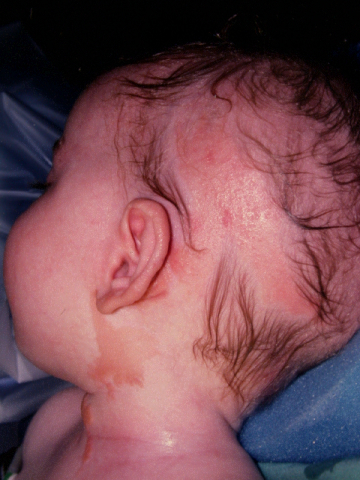Room 2 (Henry B. Gonzalez Convention Center)
Sunday, November 3, 2002
8:00 AM - 4:00 PM
Room 2 (Henry B. Gonzalez Convention Center)
Monday, November 4, 2002
8:00 AM - 4:00 PM
Room 2 (Henry B. Gonzalez Convention Center)
Tuesday, November 5, 2002
8:00 AM - 4:00 PM
Room 2 (Henry B. Gonzalez Convention Center)
Wednesday, November 6, 2002
8:00 AM - 4:00 PM
588
P51 - Surgical Management of the Cutaneous Manifestations of Linear Nevus Sebaceus Syndrome
Linear nevus sebaceus syndrome (LNSS) is characterized by the association of linear nevus sebaceus with abnormalities of the central nervous system, eyes and bones, other cutaneous alterations and malignancies. The plaques of nevus sebaceus are hairless and verrucous, and the color ranges from yellow-orange in white individuals to hyperpigmented in black patients. Typically, the scalp and the face are severely involved. Patients with nevus sebaceous, whether associated with LNSS or solitary, have a 10 to 20 percent risk of the development of cutaneous neoplasia, especially basal cell carcinoma and syringocystadenoma pappiliferum. These tumors usually develop after puberty. While extensive literature describes the dermatologic, neurologic as well as ophthalmologic manifestations of LNSS, the surgical approach to these complex head and neck lesions has not been previously described. We present a cohort of 5 consecutive patients with diagnosis of linear sebaceous nevus syndrome with lesions covering extensive areas of the face and scalp, all were treated in our institution within the last 10 years. All patients were treated with expansion of the adjacent texture, color, and adnexal matched skin as the primary modality of treatment. Planning for expansion and serial excision is complicated by the widely scattered "patchy" distribution of the lesions, unlike the typical congenital pigmented nevi. Full thickness skin grafts, local skin flaps and prefabricated flaps were applied for reconstruction of specific areas. These techniques were based on experience gained in treating our previously published large series of congenital pigmented nevi. To our knowledge, this report represents the largest surgical series and suggests a reliable approach to the treatment of the cutaneous manifestations of this syndrome.

View Synopsis (.doc format, 32.0 kb)
See more of Posters
Back to 2002 Complete Scientific Program
Back to 2002 Meeting home
